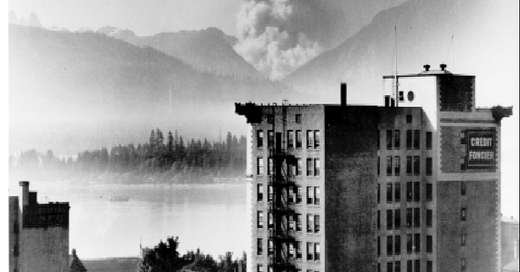It happened 100 years ago today: British Columbia’s post-solstice heat dome
Newspaper reports from June 1925 describe oppressive heat and wildfires.
One-hundred years ago today, the South Coast of British Columbia experienced the kind of weather that would not happen again until June 2021.
An unusual heat wave during the long days just after the summer solstice, with little relief during the short, hot nights.
“Whole Coast is Gasping For Air” screamed the Vancouver Province front page headline on June 25, 1925.

The hottest day of that year, 29.4 degrees Celsius by noon. Vancouver beaches “began to resemble the sacred watering places of India, so great was the crowd seeking relief.”
Ishmael Aeli, a 40-year-old, collapsed in front of his home on East Hastings near Abbott. He was in serious condition.
“Hot weather passed the joke stage today,” the Province reported.
Vancouver was not alone. Medford, Ore. reached 42.6 degrees Celsius. Aberdeen, Wash. 37.7 degrees. A day earlier, Portland was 37.2.
Even B.C.’s capital Victoria was sweltering. The Daily Colonist newspaper reported that it experienced bright sunshine on average 15 hours per day for three days and the thermometer hit 31 degrees at the Gonzales Observatory on June 24, 1925.
“The warmest day in June since the records were kept here, covering the long period of 51 years, was reported here yesterday,” according to the Colonist.
Conditions were ripe for wildfires.
On the June 26, 1925 front page, “Fire Wipes Out West Coast Indian Village of Clayoquot.”
Twenty-three houses and the Roman Catholic Mission Church burned. No mention of lives lost or injuries in the telegram.
A bigger, more consequential fire on Vancouver’s North Shore, near what is today Capilano Lake.
“Two bridges, one donkey engine, more than 1,000 acres of logged off lands and about 300,000 feet of merchandisable timber on the outskirts of timberlands went up in flames [June 25] when fire starting this afternoon, three miles above the Capilano intake spread rapidly to the surrounding country.”
Officials of the Capilano Logging Company said they brought it under control. But that was only temporary.
The Rapid Creek Fire, as it came to be known, burned through the summer. Protecting the watershed became a primary focus of the 1924-formed Greater Vancouver Water District and its 1926-hired Commissioner Ernest Cleveland.
Fast forward to 2021, when 619 people died of heat-related illness between June 25-July 1, according to the B.C. Coroners Service. The deadliest natural disaster in Canadian history.
It reached 38 Celsius with humidex in Abbotsford on the first day, 40 Celsius in Victoria on June 28 and an all-time Canadian record 49.6 Celsius in Lytton on June 29, 2021.





